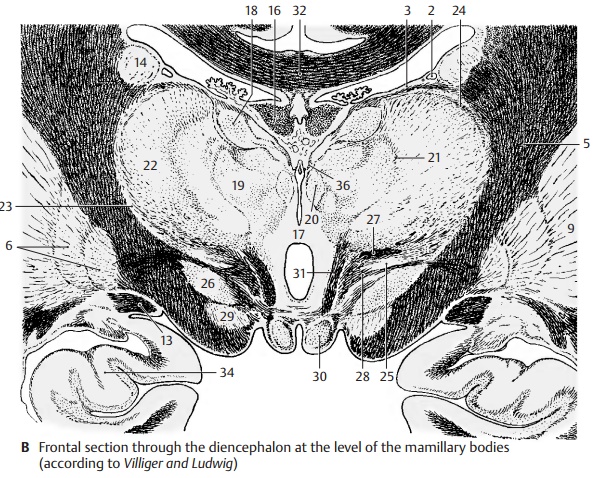Chapter: Human Nervous System and Sensory Organs : Diencephalon
Frontal Section at the Level of the Mamillary Bodies
Frontal Section at the Level of the Mamillary Bodies
The section shows both thalami; their in-crease in volume has lead to secondary fu-sion in the median line, resulting in the in-terthalamic adhesion (B17). Myelinated fiberlamellae, the medullary layers of thelies the anterior nuclear group (B18), ven- trally to it the medial nuclear group (B19), which borders medially on several small paraventricular nuclei (B20) and is laterally separated by the internal medullary layer (B21) from the lateral nuclear group (B22).
Subdivision of the latter into a dorsal and a ventral area is less distinct. The entire com- plex is enclosed by a narrow, shell-shaped nucleus, the reticular nucleus of the thalamus (B23), which is separated from the lateral nuclear group by the external medul- lary layer (B24). Ventrally to the thalamus lies the sub- thalamus with the zona incerta (B25) and the subthalamic nucleus (Luys’ body) (B26). The zona incerta is delimited by two myelinated fiber plates, dorsally by Forel’s field H1 (thalamic fasciculus) (B27) and ventrally by Forel’s field H2 (lenticular fasciculus) (B28). Below the subthalamic nucleus appears the rostral pole of the substantia nigra (B29). The floor of the diencephalon is formed by the two mamillary bodies (B30). The mamil- lothalamic fasciculus (Vicq d'Azyr’s bundle) (B31) ascends from the mamillary body to the thalamus.
AB32 Corpus callosum.
A33 Amygdaloid body (amygdala).
B34 Hippocampus.
A35 Anterior commissure.
B36 Medullary stria.


Related Topics